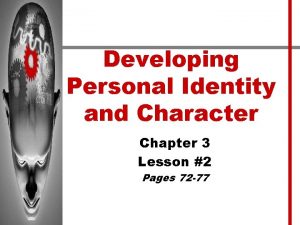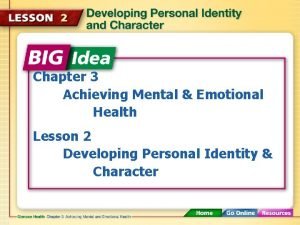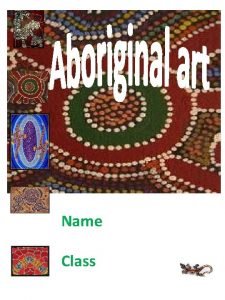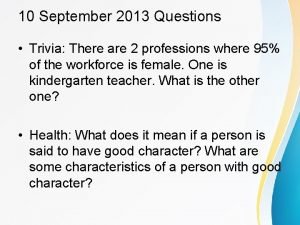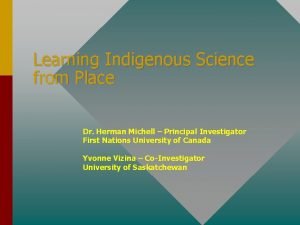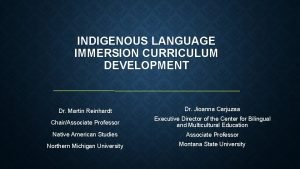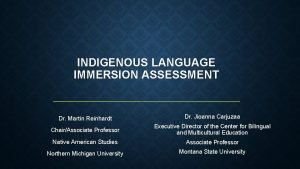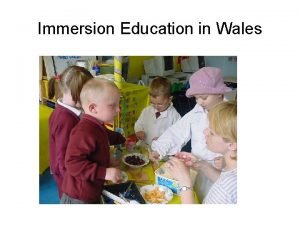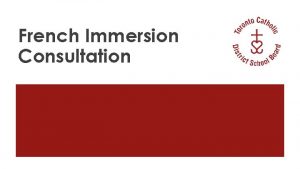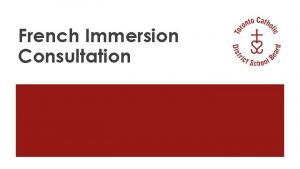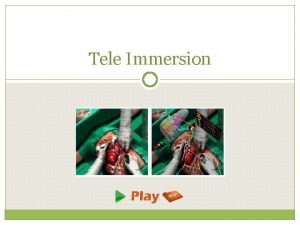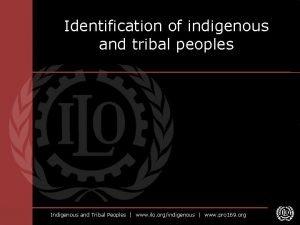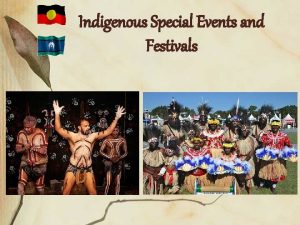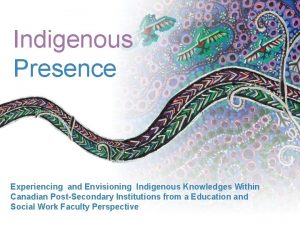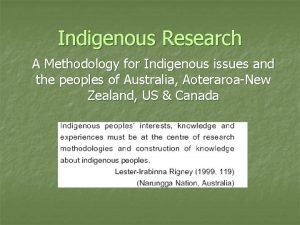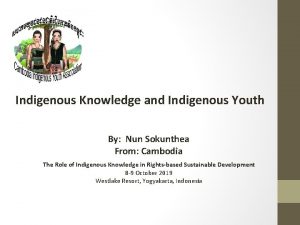DEVELOPING AND IMPLEMENTING AN INDIGENOUS LANGUAGE IMMERSION LESSON


















- Slides: 18

DEVELOPING AND IMPLEMENTING AN INDIGENOUS LANGUAGE IMMERSION LESSON PLAN Dr. Martin Reinhardt Dr. Jioanna Carjuzaa Chair/Associate Professor Executive Director of the Center for Bilingual and Multicultural Education Native American Studies Associate Professor Northern Michigan University Montana State University

ABOUT THE PRESENTERS Dr. Martin Reinhardt Marty is an Anishinaabe Ojibway citizen of the Sault Ste. Marie Tribe of Chippewa Indians from Michigan. He has a Ph. D. in Educational Leadership from the Pennsylvania State University, where his doctoral research focused on Indian education and the law with a special focus on treaty educational provisions. His current research focuses on revitalization of traditional Indian education systems. Dr. Jioanna Carjuzaa Jioanna holds a Ph. D. in Multicultural, Social and Bilingual Foundations of Education from the University of Colorado. Boulder. At MSU she serves as the Executive Director of the Center for Bilingual and Multicultural Education. She is grateful to serve as the facilitator for IEFA professional development opportunities, as the co-advisor to American Indian Council, and as the faculty advisor for Wanji Oyate Education Cohort for Native students pursuing teaching careers. She is leadauthor of Teaching in the Middle and Secondary Schools, Pearson's leading methodology textbook which is now in its 11 th edition. She was the recipient of the 2013 G. Pritchy Smith Multicultural Educator of the Year Award.

INTRODUCTION OF TEXTBOOK Now in its 11 th edition, Teaching in the Middle and Secondary Schools remains an influential text for preservice and in-service teachers who work with adolescents. Written by an expert on multicultural education, diversity and cultural differences among students are thematically integrated throughout this text and applied to all areas of study. Containing activities that focus on student-centered learning, real life scenarios that apply critical teaching skills, and inchapter exercises and end-of-chapter activities, this text is both practical and applicable as a valuable instructional text and future resource for professionals. The new 11 th edition is tech savvy and updated, including a greater focus on middle school teaching methods and curriculum, twenty-first century skills, and analysis of student assessment and achievement.

WEBINAR GOALS • Familiarize participants with the components of a general lesson plan using an Anishinaabemowin immersion lesson plan example. • View a video of the example lesson plan implementation. • Discuss reactions to the video.

COMPONENTS OF A TYPICAL LESSON PLAN • 1. Descriptive Data (page 187): • Teacher: Barbara Nolan • If you are planning and implementing an Indigenous language immersion lesson in collaboration with a regular content area teacher, you should include both names here. • Class: Indigenous Language Immersion Example for Webinar • Date: January, 2016 • Grade level: 3 rd • Room number: Old School Classroom Studio, Gwinn, Michigan • Period/Time: 1 hour • Unit: History and Geography: Asking Questions, Creating Timelines, and Directions. • Lesson number: 1 of 5 • Topic: Anishinaabe Medicine Wheel History and Geography

LESSON COMPONENTS CONT. • 2. State, Common Core State Standards, and/or National Standard(s) (Which specific subject/grade standard is being addressed? ) (pages 122 -125) • State of Michigan Standards: • History (3 – H 3. 0. 1) Identify questions historians ask in examining the past in Michigan (e. g. , What happened? When did it happen? Who was involved? How and why did it happen? ). • History (3 – H 3. 0. 10) Create a timeline to sequence early Michigan history (American Indians, exploration, settlement, statehood). • Geography (3 – G 1. 0. 1) Use cardinal directions (north, south, east, west) to describe the relative location of significant places in the immediate environment.

LESSON COMPONENTS CONT. • 3. Goals and Objectives: • Instructional Goals (from the teacher’s point of view): • 1. To review and introduce general Anishinaabemowin terms associated with the Anishinaabe medicine wheel. • 2. To model how to ask questions about the past in Anishinaabemowin. • 3. To review Anishinaabemowin terms associated with an Anishinaabe timeline. • 4. To acquire knowledge about the cardinal directions in Anishinaabemowin associated with each part of the medicine wheel. • Specific Objectives (what the students will be able to do or what they will know as a result of your lesson): • Cognitive: The students will be able to (TSWBAT) demonstrate on how the Anishinaabe medicine wheel can be used to discuss time and directions. • Affective: TSWBAT practice asking each other questions in Anishinaabemowin related to the medicine wheel. • Psychomotor: TSWBAT create their own medicine wheel and timeline by utilizing what they have learned.

LESSON COMPONENTS CONT. • 4. Rationale (Why teach this lesson? How does it fit into the curriculum? ) (page 189): • The medicine wheel is a fundamental teaching tool for the Anishinaabek. It symbolizes the relationship between individuals and all things in life. It can be used to conceptualize temporal as well as spatial relations.

EXAMPLE COMPONENTS CONT. • 5. Procedure (Procedure with time plan, with modeling examples, transitions, guided practice experiences, etc. ) (page 189): • Introduction: Introduce the lesson and go over expectations (5 minutes). • Activity 1: Introduction to the Anishinaabe Medicine Wheel (5 minutes). • Activity 2: Draw an Anishinaabe Medicine Wheel (15 minutes). • Activity 3: Introduction to the Anishinaabe Timeline (15 Minutes). • Activity 4: Draw an Anishinaabe Timeline (15 minutes). • Activity 5: Ask Questions about the Past in Anishinaabemowin (5 minutes). • Activity 6: Practice Saying “I saw you”, “I see you”, and “I will see you” in Anishinaabemowin (5 minutes).

EXAMPLE COMPONENTS CONT. • 6. Assignments and Reminders of Assignments (page 191): • Possible homework assignments related to this lesson: • Make your own medicine wheel at home with your family. • Teach someone the Anishinaabemowin words you remember. • Make a calendar of events that happened last week using an Anishinaabe timeline. • Practice saying I saw you, I see you, and I will see you in Anishinaabemowin by talking to yourself in the mirror each day.

EXAMPLE COMPONENTS CONT. • 7. Materials and Equipment Needed (page 192): Power. Point slides for: Expectations (what to do) Image of compass Medicine wheel with Anishinaabemowin terms for drawing a medicine wheel Images of a clock and monthly/annual calendars Anishinaabe timeline (spiral) with days of a week Anishinaabemowin terms for drawing a timeline with image of a birthday cake Asking the question “What did they do yesterday” in Anishinaabemowin Saying “I saw you, I see you, and I will see you” in Anishinaabemowin Audiovisual: -computer with Internet access -projector with screen Other: -construction paper -crayons/colored pencils -whiteboard/dry erase markers -Medicine wheel wall hanging

EXAMPLE COMPONENTS CONT. • 8. Accommodations for Students with Special Needs (Specifically describe what you plan to do to ensure the success of each and every one of your students who is identified as having special needs. ) (page 192; see chapter 3): • Talented and Gifted (TAG) • TSWBAT display and explain their individual medicine wheel to the class in a short presentation using the terms learned in this Anishinaabe lesson supported by English. • TSWBAT research varying medicine wheels using the Internet, take a virtual tour of the Bighorn Medicine Wheel in Wyoming, and compare and contrast the Ojibway and Plains Indians medicine wheels.

EXAMPLE COMPONENTS CONT. • 9. Assessment of Student Learning (This needs to be tied directly to instructional objectives) (page 193): • Anishinaabemowin Immersion Lesson Assessment Rubric. • 10. Reflection/Evaluation (Discuss the relative success or failure of your lesson) (page 193): • Reflective Thoughts about Lesson: • Suggestions for Revision: • 11. References: • Michigan Department of Education. (2007). Social studies grade level content expectations: Grades K-8. • http: //www. michigan. gov/mde/0, 4615, 7 -140 -28753_38684_28761 ---, 00. html

QUESTIONS/ANSWERS • If you have any questions for the presenters about the previous slides go ahead and ask them now. • You may type them into the chat box, or unmute your speaker and ask them verbally.

BREAK TIME • Let’s take a 5 minute break and when we return we will watch the implementation of the lesson plan. • Anishinaabe Bimaadiziwin Video with Barbara Nolan • https: //www. youtube. com/watch? v=e 7 EBx. YF 75 q. I&feature=youtu. be

BREAK TIME • Let’s take another 5 minute break and when we return we will have a group discussion about the lesson implementation and we can try to answer any questions you all might have.

GROUP DISCUSSION • How closely did the lesson follow the lesson plan? • What are some other ideas that you have for teaching about the geography or history in a Indigenous language immersion educational environment? • Other insights or questions?

MIIGWECH (THANK YOU)
 Developing personal identity and character
Developing personal identity and character Chapter 3 achieving mental and emotional health
Chapter 3 achieving mental and emotional health Pros and cons of dual language programs
Pros and cons of dual language programs Makinti naparanaka
Makinti naparanaka Chapter 3 achieving mental and emotional health
Chapter 3 achieving mental and emotional health Lesson 8 developing good character
Lesson 8 developing good character Chapter 7 strategic management
Chapter 7 strategic management Mis issues in strategy implementation
Mis issues in strategy implementation Chapter 7 strategic management
Chapter 7 strategic management The pricing tripod
The pricing tripod Designing and implementing brand strategies
Designing and implementing brand strategies Designing and implementing branding strategies
Designing and implementing branding strategies Crm project plan
Crm project plan Implementing strategies management and operations issues
Implementing strategies management and operations issues Toyota brand architecture
Toyota brand architecture Implementing strategies management and operations issues
Implementing strategies management and operations issues Indigenous axiology
Indigenous axiology Colours of medicine wheel
Colours of medicine wheel Examples of indigenous science
Examples of indigenous science
